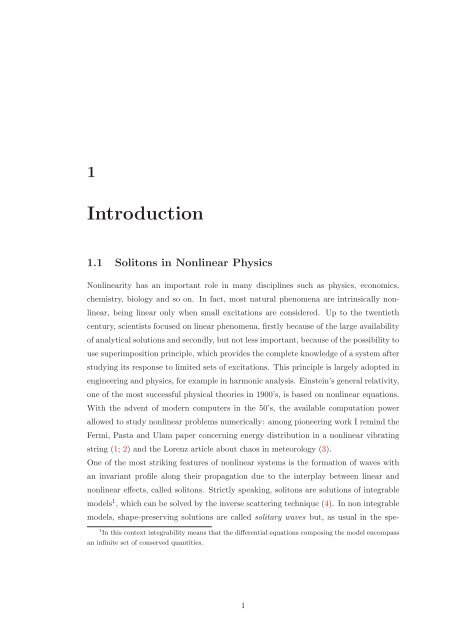Solitons in Nonlocal Media
Solitons in Nonlocal Media
Solitons in Nonlocal Media
You also want an ePaper? Increase the reach of your titles
YUMPU automatically turns print PDFs into web optimized ePapers that Google loves.
1<br />
Introduction<br />
1.1 <strong>Solitons</strong> <strong>in</strong> Nonl<strong>in</strong>ear Physics<br />
Nonl<strong>in</strong>earity has an important role <strong>in</strong> many discipl<strong>in</strong>es such as physics, economics,<br />
chemistry, biology and so on. In fact, most natural phenomena are <strong>in</strong>tr<strong>in</strong>sically non-<br />
l<strong>in</strong>ear, be<strong>in</strong>g l<strong>in</strong>ear only when small excitations are considered. Up to the twentieth<br />
century, scientists focused on l<strong>in</strong>ear phenomena, firstly because of the large availability<br />
of analytical solutions and secondly, but not less important, because of the possibility to<br />
use superimposition pr<strong>in</strong>ciple, which provides the complete knowledge of a system after<br />
study<strong>in</strong>g its response to limited sets of excitations. This pr<strong>in</strong>ciple is largely adopted <strong>in</strong><br />
eng<strong>in</strong>eer<strong>in</strong>g and physics, for example <strong>in</strong> harmonic analysis. E<strong>in</strong>ste<strong>in</strong>’s general relativity,<br />
one of the most successful physical theories <strong>in</strong> 1900’s, is based on nonl<strong>in</strong>ear equations.<br />
With the advent of modern computers <strong>in</strong> the 50’s, the available computation power<br />
allowed to study nonl<strong>in</strong>ear problems numerically: among pioneer<strong>in</strong>g work I rem<strong>in</strong>d the<br />
Fermi, Pasta and Ulam paper concern<strong>in</strong>g energy distribution <strong>in</strong> a nonl<strong>in</strong>ear vibrat<strong>in</strong>g<br />
str<strong>in</strong>g (1; 2) and the Lorenz article about chaos <strong>in</strong> meteorology (3).<br />
One of the most strik<strong>in</strong>g features of nonl<strong>in</strong>ear systems is the formation of waves with<br />
an <strong>in</strong>variant profile along their propagation due to the <strong>in</strong>terplay between l<strong>in</strong>ear and<br />
nonl<strong>in</strong>ear effects, called solitons. Strictly speak<strong>in</strong>g, solitons are solutions of <strong>in</strong>tegrable<br />
models 1 , which can be solved by the <strong>in</strong>verse scatter<strong>in</strong>g technique (4). In non <strong>in</strong>tegrable<br />
models, shape-preserv<strong>in</strong>g solutions are called solitary waves but, as usual <strong>in</strong> the spe-<br />
1 In this context <strong>in</strong>tegrability means that the differential equations compos<strong>in</strong>g the model encompass<br />
an <strong>in</strong>f<strong>in</strong>ite set of conserved quantities.<br />
1
















